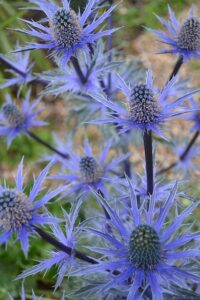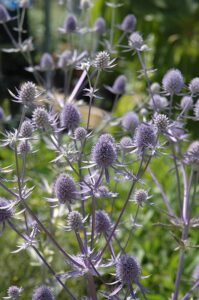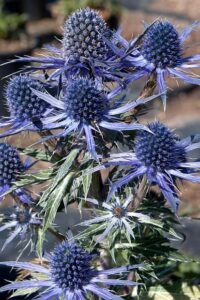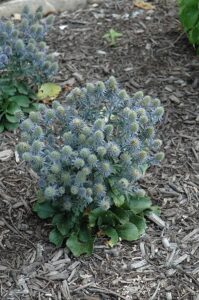Low-maintenance perennials and sea holly plants have basal clumps of dark green leaves that, from midsummer to fall, develop longer flower stems with beautiful purple-blue flowers that are like tiny shining thistles. The characteristic silver, white, green, or bluish-purple bract collar, and green or blue cones characterize sea holly flowers, native to Europe. Depending on the kind, the hues have a painted-on, metallic shine that shifts in the sunlight. Their stems can be either green or silvery blue.
Once fairly specialist, sea holly plants are now found in a limited variety at many garden centers and stores. Mature plants grow best in the spring; semi-mature nursery plants will flower in their first season, and sea holly grows swiftly. Plant seeds in late summer or early autumn, which will sprout in the spring. These are long-lived perennials once established.
Eryngium (Sea Holly) Overview

| Common Name | Sea holly, blue sea holly, star thistle |
| Common Names | Eryngium planum |
| Family | Apiaceae |
| Plant Type | Herbaceous, perennial |
| Mature Size | 2–3 ft. tall, 1–2 ft. wide |
| Sun Exposure | Full |
| Soil Type | Sandy, well-drained |
| Soil pH | Acidic, neutral, alkaline |
| Bloom Time | Summer, fall |
| Flower Color | Blue, purple |
| Hardiness Zones | 5–9 (USDA) |
| Native Area | Europe, Asia |
Sea Holly Care

As long as the right soil and sunlight are provided, sea holly plants are simple to maintain. For sea holly, you should grow it in full sun, in dry to medium sandy soil. It won’t need much care once planted. For most types, flowering begins in the middle of summer and lasts far into September.
Because sea hollies have deep tap roots that make them difficult to transport, make sure you put the plant in a long-term location. It’s an excellent choice for all those garden spots where the hose just barely reaches, as well as more challenging areas like the grassy strip between the sidewalk and the street. It thrives in coastal gardens because of its strong tolerance for salinity in the soil.
Planting taller sea holly kinds behind more robust plants, such as coneflower, will help support their stature, as they frequently require some assistance.
Light Requirements
The sea holly plants that are strongest and produce the most blooms are those that receive a full day of sun—at least eight hours. Although the plants can tolerate some shade, the lack of light may cause the stems to deteriorate and require staking in order to maintain their upright position.
Soil and Potting
For sea holly plants, well-drained, sandy, poor to moderately fertile soil makes for the ideal planting medium. Overly rich soil can cause sea hollies to spread. Compacted soil needs to be amended with compost to ensure proper drainage. Furthermore, sea holly does not care what pH the soil is; anything in the neutral range (pH 6.1–7.8) is adequate. The plants do, however, require enough drainage to avoid root rot and possible plant death.
Watering
Once established, sea holly plants are exceptionally drought tolerant due to their extensive taproot and won’t require additional water unless they experience a lengthy drought during the height of summer. However, too much surface moisture can lead to the decay of the flower’s crown, therefore sea holly plants need to be kept apart from other plants that need more water. To lessen the chance of moisture buildup, direct the water supply toward the base of the plant if and when it becomes necessary to water it.
Temperature and Environment
Sea holly doesn’t need extra warmth or humidity as long as it’s planted in its natural hardiness zones, which are zones 5 through 9. It won’t completely disappear in warmer temperatures; instead, it will thrive in the crisper spring and fall days.
Fertilization
Sea holly plants don’t require a lot of food. In actuality, plants that receive too much fertilizer will sprawl. Plant these in your garden in areas with relatively fertile yet poor soil.
Types of Sea Holly
Sea holly is constantly being introduced, taking up shelf space from more established varieties. Though they’re all quite beautiful, some do require particular growing circumstances, so find out which ones work best where you live. Here are a few of my favorites:

- One cultivar that has pink veins and edges on its variegated leaves is called “Jade Frost.”

- Gray-blue leaves and dozens of blooms per plant characterize the abundant variety ‘Blue Glitter’.

- A timeless favorite with eye-catching blue leaves and blooms is “Sapphire Blue.”

- The small variety “Tiny Jackpot” looks nice in front of a border and reaches a height of only 14 inches.
Pruning
Deadheading the spent flowers of sea holly will prolong its blooming period. Cut the plants back to almost ground level at the conclusion of the growing season. You can always leave the fall flowers on the stalks, though, as the dead flowers also look great well into winter.
Propagating Sea Holly
Although sea holly’s taproot can make propagation a little challenging, root cuttings can be used instead:
- In late summer, carefully dig up the plants, including the taproot, and remove any healthy root parts (but never remove more than one-third of the plant’s total root mass).
- Plant the individual root parts in a tiny container with a mixture of compost and vermiculite, making that the cut end (crown side) of each root segment is facing up. Replant the parent clump right once. The cut tip should be just below the surface, but the root segment should be completely buried.
- Place the pots in a protected area for the winter. The root segments should start to produce new roots in the spring, which will show up as protrusions from the pot’s bottom.
- You can move your new sea holly plant into the garden once its root system is formed and green shoots are showing above the ground.
How to Grow Sea Holly From Seed?
Though the technique is a little tricky, the majority of sea holly cultivars may be planted from seed; they will thrive if stratified (chilled to initiate the development cycle) initially. Direct seeding in the fall and waiting patiently to see what emerges in the spring is the simplest planting technique.
You can start sea holly seeds indoors to give yourself a head start. Gather seeds in the fall, refrigerate for four weeks or more, and then plant them in little pots with sand-filled potting mix. When there is no longer any chance of a frost, the seedlings can be placed outside the next spring. These seedlings, like many perennials, may require the majority of the first growing season to establish strong root systems; however, you may anticipate that they will flower in consecutive years at the anticipated period.
Potting and Repotting Sea Holly
Because sea holly dislikes the high fertility of most potting mixes, it is rarely cultivated as a potted plant on decks or patios. Soils that are sandy, dry, or even barren are far better for it. Having said that, sea holly can be grown in a container that drains well and is filled with a sandy potting mix, like a 50/50 blend of regular potting soil and succulent/cactus mix. Potted plants require careful attention to avoid overwatering them and to receive as much direct sunshine as possible.
For the winter, potted sea holly plants should be moved to a protected spot, either within a cold frame or nestled up against a garden wall. However, because sea holly requires a winter dormant phase brought on by chilly circumstances, don’t try to bring them indoors to use as houseplants.
Overwintering
If you don’t give the rosettes enough protection from the winter cold, they won’t be able to overwinter well and will instead expend all of their energy producing new leaves in the spring. Cover the plants with evergreen branches or cover them with pine needle mulch. It does not like wet winter soil, so hold off on watering it in the fall. Cut the leaves and flower stalks back to just above ground level once flowering is finished. For winter interest, you may even leave the blooms in place.
Common Pests & Plant Diseases
Nearly all pests and illnesses usually do not affect sea holly in dry soils. It may be vulnerable to root rot and fungal leaf spot infections in moist soil. Powdery mildew can also be an issue, although it can be reduced with basic watering and enough air circulation. Aphids, slugs, and snails may be attracted to moist environments and feed on vegetation.
Fungicides can aid in the management of severe leaf spot disease. Horticultural oil is usually an easy way to control aphids, or you can choose to ignore them as the harm they cause is rarely significant. You can use baits to control snails and slugs or remove them by hand.
How to Get Sea Holly to Bloom?
Growing sea holly in its usual summer-to-fall flowering time is rarely problematic when planted in well-drained soil in a sunny location. Not only may too little sun prevent a plant from blooming, but overly rich and fertile soil can also cause a plant to fail.
Common Problems With Sea Holly
While sea holly is generally trouble-free, too rich and lush soil may cause the plants to become excessively lanky and sprawling. It is therefore advisable to save this plant for areas of the garden where other plants won’t grow—that is, for areas with sandy, dry soil. Such sprawling can also happen if you overwater the sea holly or if it receives insufficient sunlight.
Also Read: Periwinkle Complete Guide To Grow And Care

Pingback: Alocasia Jacklyn Complete Guide To Grow And Care - flowerofusa.com